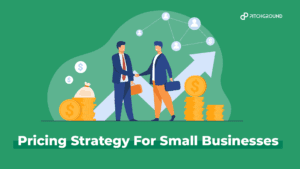You’re looking for a B2B marketing strategy, not a list of tactics. That’s why, in this article, we will show you how leading B2B companies get their customers—and the consistent thought process they follow.
Remember: a b2b marketing strategy is a plan (backed by a thought process) you follow to attract customers, position your brand, and grow, whereas it’s B2B or B2C.
However, instead of showing you the steps of a marketing plan—which includes elements like planning, setting objectives, defining buyer personas, and marketing channels, and budgets— like most blog posts do, we will focus on providing you practical insight that will help you shape your every-day thought process on B2B marketing.
We’re not showing you a step-by-step guide on how to document a strategy, nor will we share a template (that nobody uses diligently anyways).
SMBs, especially, don’t have the time to review, plan and document their marketing processes judiciously; they change weekly; theirs is more chaotic; they don’t plan for the long term but to survive for the next quarter.
This article is meant to give you a realistic, actionable approach to B2B marketing strategy to help you plan and act fast by showing you:
- How to distinguish between strategies, tactics, and growth hacks (and why it matters)
- The aspects that help you know how your B2B marketing strategy should look like
- What’s the first thing you will do today to get customers
- How not to think of B2B marketing
- How to think of B2B marketing by using flywheels (real examples included)
- How to measure your marketing efforts by using funnels
Strategies vs. Tactics vs. Growth hacks
If you read other blogs mentioning “strategies” like doing Google Ads, Facebook Ads, SEO, and content marketing, they’re tactics or channels, not strategies.
Some bloggers mention Inbound marketing as a strategy when it’s a methodology; having a plan to use the inbound methodology within your niche, product, and company, becomes a strategy.
Blogging is a tactic. Blogging to attract and convert a specific audience is part of your strategy.
A growth hacker, on the other hand, is the hybrid of a marketer and a coder; it’s someone who helps a company grow their user and customer base by using A/B tests, landing pages, viral factor, email, and quantitative analysis.
They’re the kind of people who look at technical solutions for a marketing problem. A growth hack is not a strategy, but it’s a specific practice that is meant to help businesses grow exponentially.
Have you wondered when the concept of growth became so famous?
In a conversation between Mark Zuckerberg and Sam Altman, from YC, the CEO of Facebook said he started to talk about growth when he suggested growth could be leveraged by product optimization rather than just marketing.
One of their earliest successful growth hacks was applying auto-translations. That way—while it sounded simple—represented the capacity of Facebook to expand outside English-speaking countries. And such massive growth wasn’t due to marketing activities, but a product feature.
Dennis Yu, the CEO of Blitz Metrics, turned Facebook Ads (a channel) into a methodology—that he calls the One-Dollar-a-Day plan—that is interchangeably called a plan or strategy on different blogs.
But, differencing strategies, tactics, and growth hacks are for purists. In real life, you can call them whatever you want.
I know companies that document in great detail their long-term strategy, but I feel the norm is to try something new and run different things each quarter.
Many companies don’t document their processes; therefore, they don’t have one. Get used to that.
However, you shouldn’t confuse those terms when thinking and executing the marketing of your business; if you think of marketing as pursuing a winning growth hack or just running Facebook Ads, chances to succeed are low.
This article is meant to help you build a thought process for doing B2B marketing; we’re also sharing some good examples of the strategies other companies followed to help you land yours.
B2B marketing strategy elements worth considering
These are some elements I encourage you to consider to shape the channels and approaches you will choose when implementing your marketing strategy.
Average Sale cycle time
The sales cycle time refers to the time that passes between the first contact of a stranger with your company to closing a deal.
Such a cycle depends on the ticket and level of engagement required during a sales process, among other factors.
There’s no such thing as an average; some businesses can take a few days and others, months. Corporate and Government business developers can take years to close a deal.
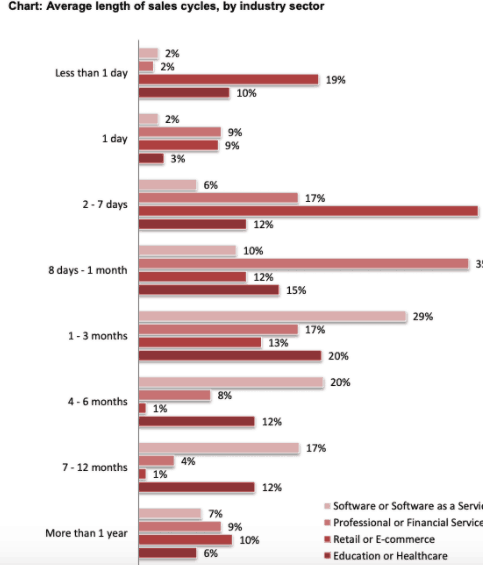
- As a rule of thumb, three quarters (74,6%) of B2B sales take at least four months to close; almost half of them (46, 6%) taking at least seven months.
- Hubspot co-founders, for instance, claimed in one conference that its sales cycle average time takes 18 months.
- “Small” deals fall within three-month-long sales cycles
- Large cycles can take between 6 to 9 months.
Eric Hale, from Y Combinator, made a brilliant presentation about Startup pricing, where he suggested the average sales cycle time, depending on the complexity and pricing—and how it affects marketing and your relation with your customers.
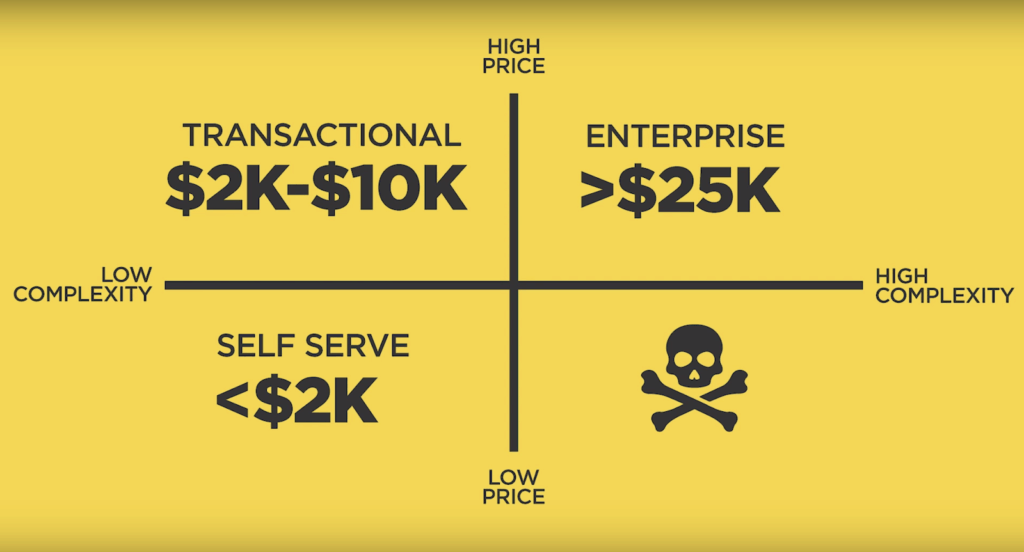
According to Eric:
If the price of your product is $2k or less, you shouldn’t have a sales team, your marketing efforts should be organic, but conversions can happen within the first day through a self-service model. For this case, I guess he refers to conversion to signups, not necessarily the transaction.
If your deals are around $2k-$10k, your marketing focuses on generating qualified leads, and you may have an in-house sales development representative. In this stage, sales cycles should be between one to three months.
Enterprise-oriented products are deals around $25k. Customer support is high touch and they require customer success representatives, and you should orient your marketing efforts towards building trust, where sales cycles can be about six and twelve months.
And, as you can see on the diagram if your sales cycle takes more months, but the pricing is low, it means your Cost per Acquisition is unsustainable.
Growth strategies
In terms of growth, you should think of three leverages: acquisition, retention, and monetization. They change the way you orient all your marketing efforts (your marketing strategy).
- Acquisition is about getting more customers
- Retention is about keeping your current customer base
- Monetization is about increasing the average ticket
Each of these leverages requires different efforts and channels. Retention is a function of customer experience; monetization is a function of perceived value and the way your business model dictates the relationship with your customers; acquisition is about marketing.
While your marketing efforts are more related to the acquisition, you can implement marketing tactics and channels to leverage both retention and monetization; they are part of the conversation during your marketing strategy.
Product/market strategies
Igor Ansoff published in the Harvard Business Review an article called “Strategies for Diversification,” where he presented the Ansoff Matrix to help businesses understand their options to grow.
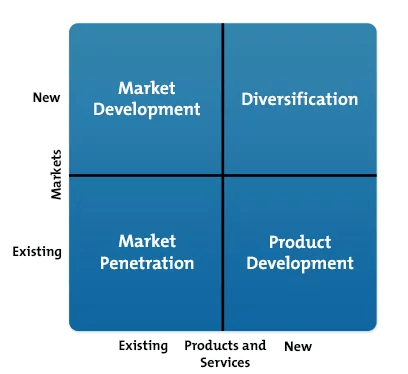
The Ansoff Matrix is a helpful tool to help you gauge your risk, based on the novelty of your product and the market you’re targeting.
Market penetration is about selling your current products to more customers within your market. Within this strategy, you should focus on indicators such as retention, market share, and increase monetization.
An example of market penetration is orienting your marketing strategy to steal market share from your competitors (i.e., taking your competitor’s customers). There are many ways to do this:
- Offering free migration from your competitor to your product and special pricing for switching.
- Bidding on Google search Ads for your competitors’ brand name.
- Targeting your competitors’ followers on social media ads like Facebook and Twitter.
- Creating content around your competitor to invite users to switch; this was the case for Kissmetrics, that dedicated part of its content marketing effort on Google Analytics tutorials to offer its web analytics tool simultaneously.
- Ranking organically on Google as a replacement or alternative to your competitor.
- There are event companies offering email lists from your competitors’ user base. I can’t tell if that’s legal or not.
Product development is about identifying new product opportunities and running marketing campaigns to sell within the current market or customer base you’re serving.
Hubspot, for instance, added a service hub to its sales and marketing software to help its users serve better their customers by enabling features like a webchat, ticket management, knowledge base, and chat flows.
Market development is about identifying new use cases of your product or changing product prices to sell to new markets.
As an example, Torre, a Remote Work job board and recruitment automation software, was initially targeting funded Silicon Valley startups that needed to hire fast. Then, they found out, among other discoveries, that entering such a market was expensive, highly competitive, and there were already established alternatives to solve that problem.
I see how they are switching their remote-only to remote-friendly job opportunities, and targeting more traditional companies outside the US that are not digitally mature and haven’t adopted remote work yet.
Diversification is about developing a new product and offering it to a new market.
Each of these strategies fundamentally changes your marketing strategy as they define your audience and the product you will offer.
As an example of diversification, Alphabet, the umbrella company behind Google, is pursuing to develop new revenue streams to reduce their dependence on their advertising business model through the search engine, Youtube and Play Store.
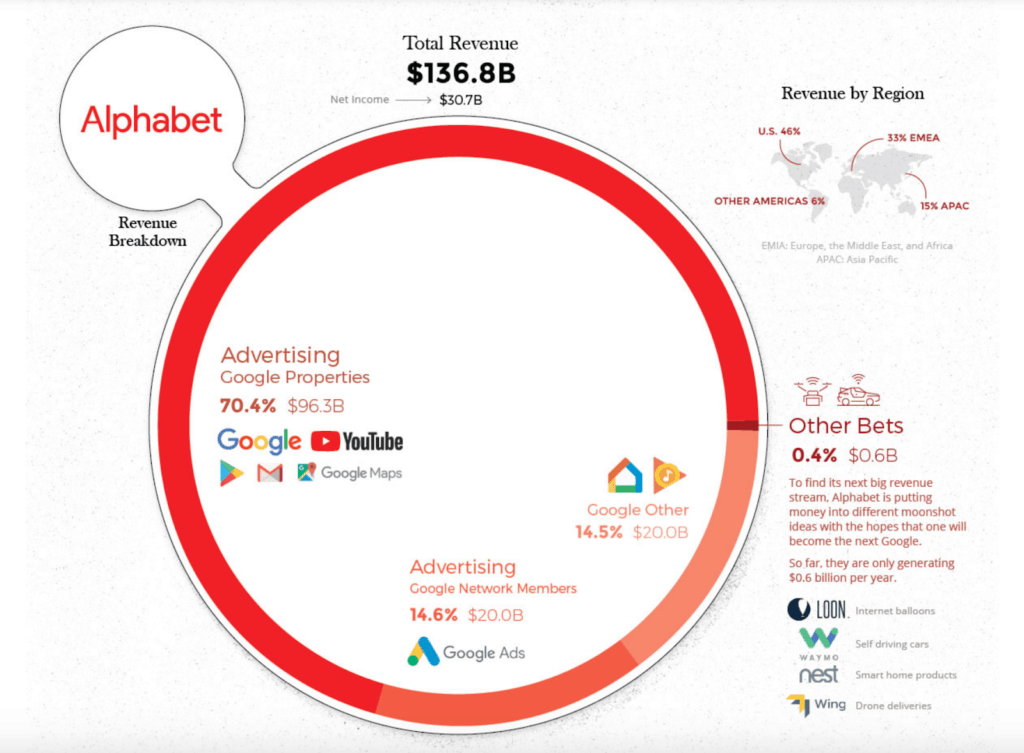
You can notice such efforts by seeing some of their billionaire acquisitions:
- In 2014, Google bought Nest, a smart thermostats company, for 3,2 billion.
- In 2019, the company bought Looker, a data visualization software for 2,6 Billion in a cash-only deal, to power its Google Cloud platform as it’s falling behind competitors like Microsoft Azure and Amazon Web Services in the business Cloud market.
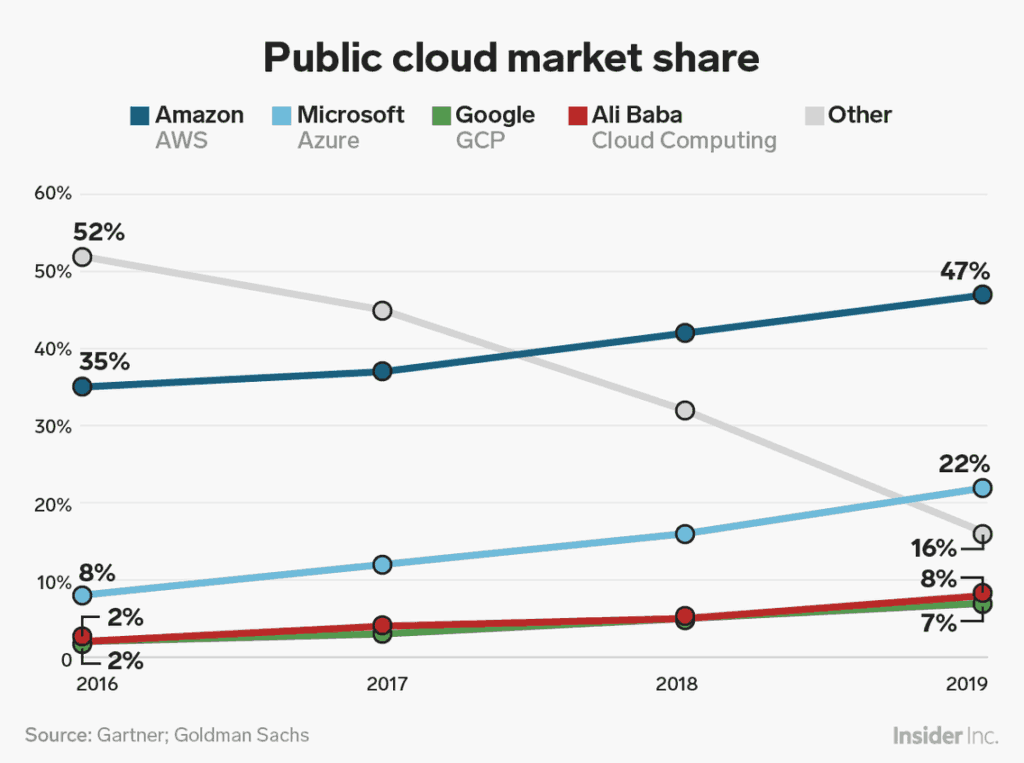
Pricing/customer base relation
The price curve and the type of users of your product affect the way you can attract new customers.
A simple way to think of it is by asking yourself how many customers and how much you need to charge each to get $1 million in sales?
| Number of customers | Average ticket |
| 1,000,000 | $1 |
| 100,000 | $10 |
| 10,000 | $100 |
| 1,000 | $1,000 |
| 100 | $10,000 |
| 10 | $100,000 |
| 1 | $1,000,000 |
There’s an inverse relationship between the number of customers you can get and the pricing you can charge (as the price curve posits), and both elements are dictated by the way you position yourself and the market you want to reach.
Companies like Slack, Zapier, or Manychat count over a million users and customers. These companies can grow through organic channels, network effects, and viral factors.
Slack, for instance, as a collaboration and chat platform for teams, encouraged new users to invite their colleagues to join their groups.
Another way the company used to leverage growth was by creating an apps library that could integrate with Slack; the bigger the library, the more valuable Slack would become, attracting more users from those apps to the chat application.
Just like Slack, Zapier leveraged the compound effect of becoming a platform. Zapier is a tool that helps you connect and integrate your favorite apps to automate tasks.
- As an example, you can integrate Google Forms and Asana to create a new task every time a new form is submitted.
- Or you can automate the creation of a new row on a Google Sheet every time a new subscriber joins your email list on Mailchimp.
If you want to learn more about using platforms to leverage growth, I recommend the “Be a Platform” podcast episode from Masters of Scale, hosted by Reid Hoffman, founder of LinkedIn.
Manychat, on the other hand, democratized Messenger chatbot development by allowing not-technical marketers to build their Messenger flows through a drag-and-drop interface.
While Manychat is a B2B product, it’s oriented not only to companies, but to individuals, like consultants, solopreneurs, and freelancers. Manychat has a subscription-based model that starts at $10/mo.
What’s the first thing you will do today to get customers (?)
Learn how to think strategically while acting tactically—and fast.
I’m shamelessly stealing the introduction of this section from these articles:
- You’ve Got Product/Market Fit… What About Marketing/Market Fit?, By Spark Toro
- How to Create a CRO Process by Peep Laja, by CXL
If you were asked to run marketing for a software company, what would be the first thing you would do?
- Researching the factors that influence the decision-making process of your audience market.
- Optimizing landing pages and running A/B tests and ads.
- Launching a free lead magnet to gather as many contacts as possible that fit within your target
- Trying to rank for commercial-intent keywords that relate to your product.
My correct, patient, and theoretic self would choose the option 1). My hurried, stressed, and anxious self (the common one) would choose option 2) because it’s the fastest thing I can test to get results right away.
Some blog posts and authors will tell you to define your target market and Unique Selling Proposition, acknowledge your strengths, weaknesses, threats, and opportunities (aka, SWOT Analysis), and ask your inner circle and potential buyers what things influence their decision making to then choose the marketing channels to act on.
And yes, that’s the number one thing you might want to do.
According to them, you should build strong strategic foundations before blindly acting on marketing channels.
I partially agree.
Having a clear value proposition and niche indeed makes things way easier.
Though reaching such insight is a more chaotic process.
Most, if not all, companies I’ve worked with or advised (excepting Pitch Ground ?) don’t have their target market well defined.
Those authors are talking from a scenario where resources are not limited, competition is not considered, you’re not starting-up, there’s perfect information about the market, consumers’ needs are crystal clear, and marketing teams are reaching their monthly goals.
That scenario doesn’t exist.
The average case is that you don’t have time and money to interview, the best source of information is Google, and you have a monthly target to reach.
Using secondary sources like market research reports or online competitive and audience intelligence tools to find insights is helpful.
Still, they hardly go beyond generic vertical, industry, and competitors data.
You want to refine your knowledge on your target audience and, possibly, the best way to do it is by talking with customers.
And then you find yourself in a vicious cycle (that I have witnessed many times): you don’t know your customers because you don’t have customers, and you don’t have customers because you don’t know them.
The way successful founders that I know at first hand follow is testing fast campaigns as if they knew their market. Every experiment ends up in a new experiment building a loop towards defining a target audience.
So, if I asked you, again, what is the first thing you would do for marketing a software company, my final answer might be pursuing the option 1) by testing options 2), 3), and 4).
While I’m not a fan of the “fake it until you make it” mantra, I acknowledge uncertainty is the baseline, even in a data-driven world.
As for my experience, acting fast and having meetings with potential customers to listen to their problems is the ultimate source to know your audience.
How to not think of B2B marketing
I can’t stress this enough: don’t think of b2b marketing as doing blogging, conversion rate optimization, and SEO.
But understanding all you do in marketing is complex. Bringing all things together is easier said than done.
I sometimes feel lost when doing mundane tasks like adding titles and descriptions of the images on a landing page.
Or when I take dozens of hours writing an article (like this one).
Everything for what? (Existentialist mode).
Then I acknowledge that optimizing those images and writing these articles represent future consistent website traffic from SEO where audiences have an intent that is expressed in searches.
We know (or guess) at Pitchground that the kind of audience that reads these articles is likely to be interested in buying many different types of software.
I also acknowledge that organic traffic can be the first touchpoint of users with a brand. They won’t buy after reading this post (if ever), but they will join a remarketing list where we will send both content and promotional offers.
If they join our email list and see us featured on Forbes, then chances to convert increase. If they like us, they might not buy, but they can recommend us when someone else is looking for the kind of products we offer.
Buying decision making is not linear or straightforward.
How to think of B2B marketing by using flywheels
Many successful companies have an ongoing, scalable marketing process that attracts and converts audiences consistently.
They don’t think of a blog post that will convert massive customers right away, but they know that consistently blogging will turn them into thought leaders for their audiences that will come to their sites back again repeatedly.
A useful metaphor to think of marketing is a flywheel (Hubspot does great explaining flywheels).
Think of a flywheel as a spiral that needs force to rotate. Faster rotation represents growth.
The more force you apply, the more “energy” energy is stored ending up in momentum: the flywheel spinning faster by itself.
Why is it useful to extrapolate flywheels—a physics concept—into marketing?
The force you apply is all those tactics and activities you perform. The more you do, the faster your flywheel spins.
You shouldn’t expect that a single blog post will do much to your flywheel, but blogging every week should add force consistently that eventually makes the flywheel rotate by itself.
If you add rotational energy by adding email marketing, PR, and affiliate marketing, that’s the additional force that will help your business spin faster.
What about the concept of storing energy and momentum to make the flywheel spin by itself?
Such abstraction is represented by brand awareness, brand positioning, and Word of Mouth.
If you fill your flywheel with customers, those customers will recommend you to other people who will land on your site. You didn’t act directly to get those new customers, but the initial force you applied leveraged them.
The fact your brand gets a positive reputation will make visitors more likely to subscribe to your newsletter and download your content, and click on your site when it’s featured on a Google search.
Eventually, Word of Mouth may attract more and more customers without the effort of spending more on advertising; Word of Mouth, again, is the momentum that makes your flywheel spins faster without applying more force.
But as we talk about force, we should speak of friction; the resistance your flywheel faces to spins faster.
It represents all those elements that make it difficult for your audience to interact and buy from your audience. A good example is a slow website. It makes visitors more likely to navigate your site and thus convert. Such a bad experience may prevent them from visiting you back.
Some examples of force and friction could be:
| Force | Friction |
| Participating and sponsoring events Actively participating in online forums or groups Publishing lead magnets on your site Creating more landing pages that help you rank on Google for more keywords Building an email list where you can send your content Constantly running remarketing campaigns on Google and Facebook Automating positive reviews collection Improving your conversion rate from subscribers to free trialsCreating product demo videos Publishing a use cases page of your product | A slow, non-responsive website Difficult payment process Unfriendly cancelation process Complex user or customer on-boarding Sending spam on email A sales rep taking days for contacting a lead The unclear value proposition on landing and homepages Ad fatigue Lack of useful content on the site Pricing pages with no clear pricing In general, delivering a poor customer experience |
- Your flywheel describes your strategy
- Each force you apply is a tactic (e.g., starting to run LinkedIn Ads)
- Dramatically optimizing the output of each force separately can be taken as a growth hack
- Each of the daily activities your perform count; they’re applying force to your flywheel
- Instead of shooting one ad and begging, it will turn strangers into customers with hyped copy, think of a repetitive process that articulates all channels
- Short-term activities feed long-term success
- Instead of merely increasing your ad budget, a quick win could be identifying easy-to-solve friction points and acting on them
- Metrics like conversion rates, churn rate, bad reviews, and low NPS are friction signals
- Consistently collecting customer feedback is essential as it helps you spot friction points
To help you understand and adopt flywheels, we will share some examples from successful companies.
Moz’s marketing strategy
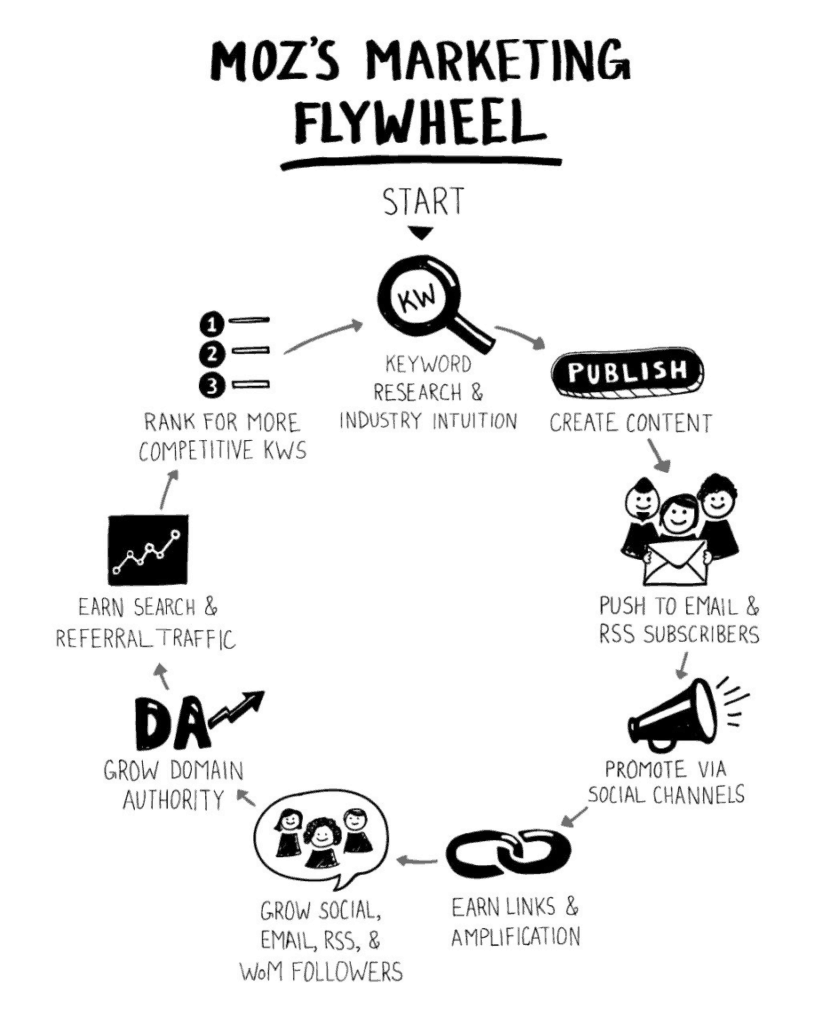
Moz is a well-known SEO software company. They target market—agencies, digital marketers, and webmasters—find them and learn from Moz by finding their blog posts on Google, Social Media, WOM, conferences, email subscriptions, referring links from other websites, mentions on the press, etc.
The flywheel stats with keyword research; Moz finds the keywords and topics their target audience is searching on Google to create useful content around them.
Then Moz distributes and amplifies their content by ranking organically on Google, posting on social media, attending conferences, gathering and sending emails, earning referral links from other websites, and by being mentioned on media sites, among other tactics.
As SEO experts, part of the company’s ongoing activities are earning backlinks from other sites to increase their domain authority.
However, earning backlinks and publishing and syndicating their content on other sites is a tedious process—a friction point.
There’s where they come up with tricks or growth hacks such as:
- Creating roundup articles citing experts and influencers in their niche. In return, those experts will share the content pieces on their social media accounts.
- Moz will complement their blog posts with infographics that can be used by other bloggers by simply embedding a code.
- Offering free tools that other bloggers and experts will feature on their articles.
Moz required a lot of force and years to end up with such a successful flywheel that drives millions of visitors and thousands of leads to their site each month.
But, like a real flywheel, it took a lot of energy to get theirs spin in the beginning.
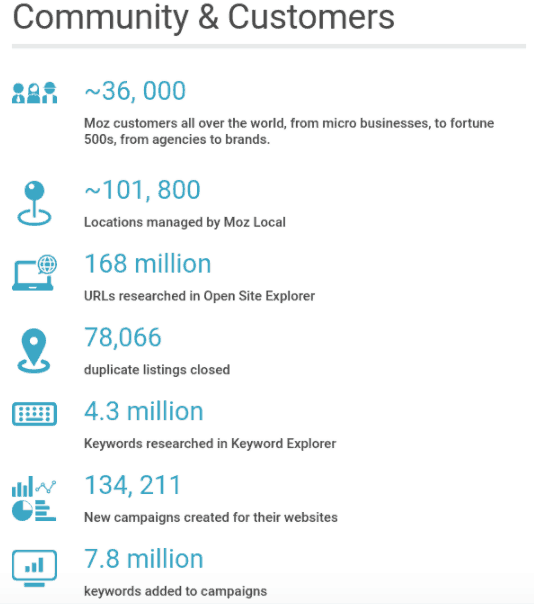
Back in the first years of the company, Rand Fishkin, Moz co-founder, used to blog five times every week, to end up reaching a few dozens of people.
Eventually, such content would start reaching hundreds and thousands of people. According to Rand, one of the turning points was a nearly-forty-page guide called the “Beginner’s Guide to SEO” that was featured on relevant sites that converted Moz into an authority in the industry.
That’s what we could call a success case. But it only went after days and nights of hard work.
As a lesson, when thinking of your marketing strategy, think of consistency rather than pursuing that elusive growth hack.
I attended a Rand’s conference when he shared that WhiteBoard Friday, his renowned youtube lessons series, Moz’s most successful content, used to be the worst performing when it started.
Dollar Shave Club marketing strategy
Dollar Shave Club is a subscription-based business that offers men razor blades for a few Dollars (not just a Dollar) built a flywheel that started with a set of funny videos that became viral, like this one:
The company leveraged such massive loads of web traffic with re-marketing—besides ranking on Google for high-intent keywords and earning news coverage—to turn such an audience into a customer base that was worth 1 Billion for Unilever.
Zillow marketing strategy
Zillow is a market leader in real estate. They made their flywheel spin by creating and patenting a home price calculator called “Zestimate” that would derive on shares, conversations, and amplification.
Such traction was followed by content creation, social media, and a cascade of digital marketing channels that would end up in positioning Zillow as a source of real estate data.
To me, Zestimate is something that you could call a growth hack. It’s a free online tool that can get tons of traffic at a low cost.
WP Engine strategy
WP Engine is the go-to hosting provider for many companies that need to maintain their site during viral traffic peaks.
Many site owners experienced what they called “Reddit Hug of Death”, which represented the fact that Reddit and other forums would drive insane amounts of traffic to a site to the point of turning down.
WP Engine owned its reputation by blogging about managing WordPress sites. They leveraged their content by repurposing it with videos and distributing it through other channels, like email lists.
Amazon strategy
This diagram was used by Jeff Bezos to describe Amazon’s business model.
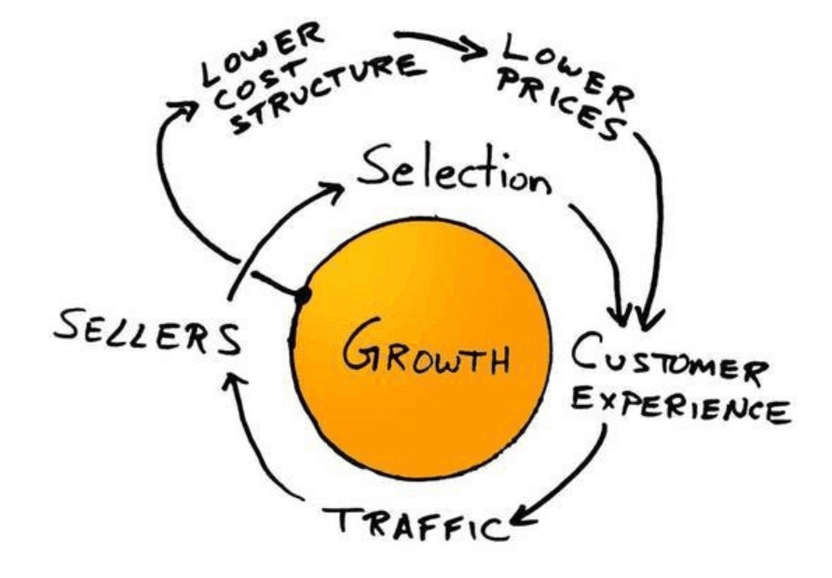
- Amazon attracts more and more sellers to promote their products on Amazon, increasing the selection.
- Such a big selection brings more traffic as it turns into a more satisfying customer experience.
- More growth leverages a lower-cost infrastructure due to the economies of scale principle, allowing Amazon to offer lower prices, improving the customer experience.
- Such customer experience, again, drives more traffic, forming a virtuous cycle.
There are many more forces and ways Amazon has identified to remove friction.
- The company has one of the most well established and recognized affiliate programs; the program pays a commission to bloggers and site owners that use referral links to Amazon that drive conversions on the site.
- Amazon has an unbeatable logistic chain that allows them to offer free, fast delivery.
- They complement their marketing efforts with a strong bet on remarketing ads running always.
Customer experience is at the center and core values of every Amazon employee. Customer experience fuels the momentum of the Flywheel.
Such customer experience makes more people go to Amazon’s site (i.e., drives more traffic).
- Excellent customer experience drives traffic to Amazon.com.
- Sellers are attracted to put their products on Amazon.com.
- This would create a greater selection of products for customers. At the same time, the increased sales on Amazon.com allows Amazon to lower their cost structure and reduce prices. This, along with customer experience, increases the traffic on Amazon.com.
Once the sales cycle — or Flywheel — starts to take effect, each element begins to increase, and it takes on a life of its own. Traffic increases leading to more sales, leading to lower prices, etc. All of this results in the accelerated growth experienced by Amazon.com.
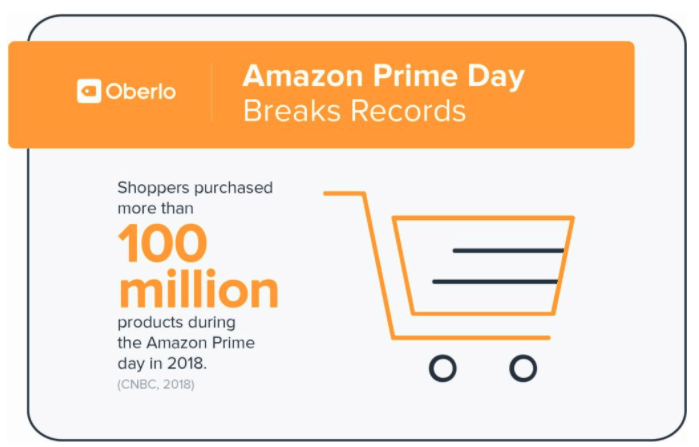
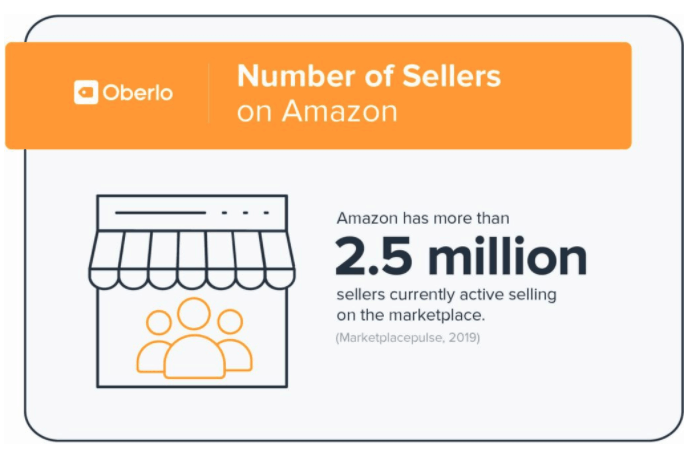
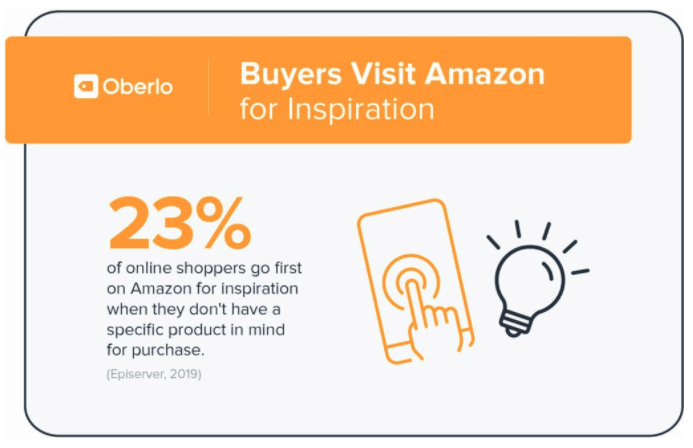
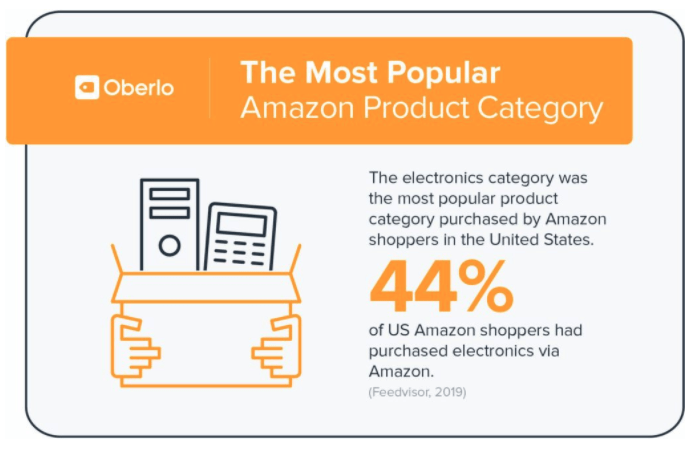
Hubspot strategy
Hubspot is the company that openly shares its flywheel with great detail.
In September in 2018, I attended Hubspot’s Inbound, an event that gathers more than 20,000 digital marketers and enthusiasts from all around the world.
While there are dozens of speakers, most of us were expecting to hear what Brian Halligan and Dharmesh Shah, Hubspot Co-founders, had to say.
All Hubspot’s and virtually all digital marketing software companies’ narrative revolves around funnels; they serve as a lovely and suggestive way to visualize marketing complexities.
Their presentation was about how they would kill the funnel to bring the flywheel.
I bet I wasn’t the only one thinking they were re-labeling, trying to reinvent the wheel, and use a different word for the same concept.
But they happen to be great storytellers, and we bought the idea.
Brian has interviews with customers every week. Among other questions, he asks them how they got to know Hubspot?
Like me, the most common response used to be through their blog.
But Hubspot is already one of the most reputable B2B brands around the world and a Fortune 500 that has been growing for more than ten years straight.
At some point, Hubspot’s most crucial marketing channel wasn’t it’s content, but it’s customers.
Your customers are your most important marketing channels.
After some point, their primary customer source was Word of Mouth.
They claimed that visualizing marketing as a funnel made converting visitors to customers the output and end of the process.
But visualizing marketing as a flywheel made their customers not just be the output but also the input to bring more traffic, leads, and new customers. Again, Flywheels serve as a great metaphor to understand the compound effect of building a brand that brings customers without the direct participation of marketing activities.
What makes their flywheel stand out is that the company breaks it down into three stages: from a customer perspective, they’re attraction, engagement, and delight; from the company perspective, they’re marketing, sales, and service.
- Marketing is about attracting leads to your site.
- Sales are about closing them.
- Service is about retaining and delighting them, so they recommend you.
The company identified friction points in each of their three stages and made changes to them.
For marketing, the friction points and solutions were:
For sales, they were:
And for service they were:
If you want to follow their process to identify friction points and find ways to solve them, I recommend you to read “How the Flywheel Killed Hubspot’s funnel”.
B2B funnel and metrics
Flywheels don’t mean the death of funnels.
Both describe marketing complexities and abstractions.
Flywheels describe the compound effect of your marketing activities; funnels describe the linear process that a user takes towards becoming a customer from the marketer’s perspective.
The marketer’s perspective involves metrics.
Those metrics help understand the input and output of each stage.
They have the shape of a funnel because you always expect the output is smaller than the input; you cannot have more leads on your site than traffic.
We will close this blog post by explaining some of the core metrics and KPIs you should track for your b2b marketing funnel: traffic and conversion.
Website traffic represents demand and sales potential. Traffic is the outcome of all your marketing tactics to bring strangers to your website.
But to get traffic, you need to grow other indicators that represent awareness and engagement on different marketing channels.
To get traffic, you need to reach an audience. While it is hard to identify the ROI of social media likes, shares, and engagements, you can consider them as a step towards the traffic.
To reach an audience you need to amplify your message and, ideally, start a conversation. A way to gauge and leverage larger audiences is by generating engagement: the more shares and likes you get, the more reach your brand is getting, and the more traffic they can generate.
This is, of course, more theoretical than practical.
Those metrics don’t say too much about the quality of your audience, and social media networks are not the greatest generators of website traffic; Facebook wants its users on the social network; people rarely click your links on Instagram, they easily swipe your photos and give you likes and re-posts.
If amplification and getting many users are part of your marketing strategy, social media metrics matter. If you’re focusing on high-quality lead generation, social media may fall short among other channels.
But if you`re pursuing to generate traffic from higher-intent audiences, SEO and paid ads are a must.
Just for the record, the main source of traffic in SaaS companies is SEO, and it tends to be the major acquisition channel for some B2B companies.
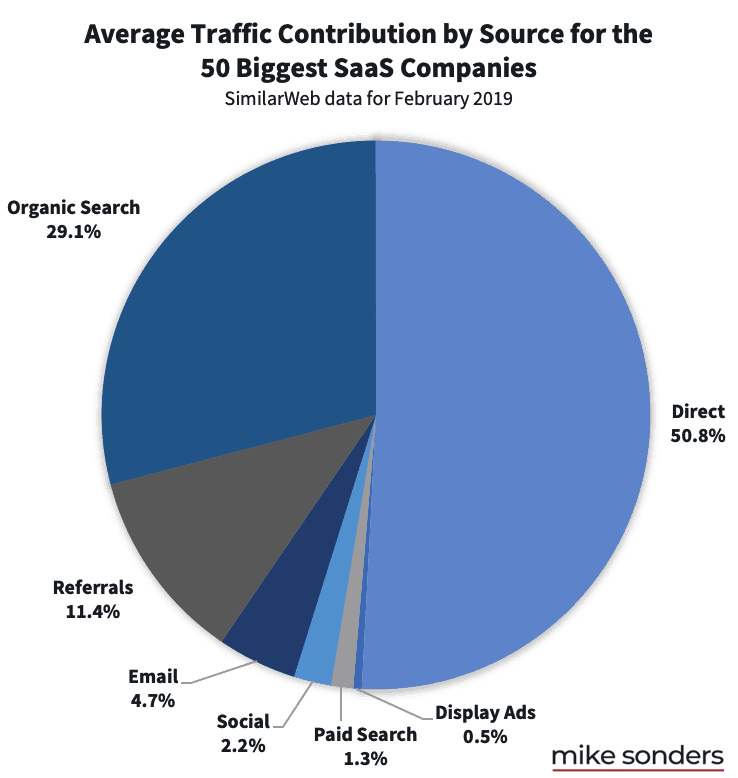
Conversion rate, on the other hand, is the relation between an input and an output and it represents your effectiveness to get the most output as possible.
Conversion rate is not only about comparing the number of visitors who turned into customers but the percentage of effectiveness of each of your marketing channels, tactics, and activities.
Conversion rates worth measuring are:
- Website visits to leads
- Leads to customers
- Website visits to free trials
- Free trials to customers
- Landing page visits conversions
- Leads to MQLs
- MQLs to SQLs
- SQLs to opportunities
- Opportunities to closes
The input is always traffic; the output are those goals that you define as conversions.
As you can see, the conversion rate serves as the key performance indicator to identify which stage of your funnel is worth optimizing.
By the way, if you’re not familiar with acronyms like MQLs, here’s a brief recap:
- Lead: every new contact on the website; anyone who fills a form
- MQL (Marketing Qualified Lead): a lead whose profile has the potential to be a customer (is qualified to be marketed)
- SQL (Sales Qualified Lead): don’t confuse it with a programming language; SQLs are the contacts who have expressed buying intent. Someone who fills a demo request or quote request is a SQL.
- Opportunity: opportunities are all those leads who have had a meeting with your company and have heard your offer
All these states or categories your audience can fit describe your marketing funnel.
As such, funnels help you identify in what stage of the marketing processes you need to optimize and work on. It’s not just about lacking customers.
What’s next
Thanks for making it to the end of the post! Now you should understand the concepts you need to think about and execute your B2B marketing strategy. If you want to learn more about digital marketing and SaaS businesses, we encourage you to read:

